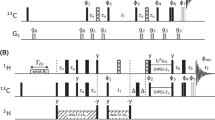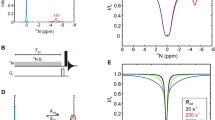Abstract
For the past decade chemical exchange saturation transfer (CEST) experiments have been successfully applied to study exchange processes in biomolecules involving sparsely populated, transiently formed conformers. Initial implementations focused on extensive sampling of the CEST frequency domain, requiring significant measurement times. Here we show that the lengthy sampling schemes often used are not optimal and that reduced frequency sampling schedules can be developed without a priori knowledge of the exchange parameters, that only depend on the chosen B1 field, and, to a lesser extent, on the intrinsic transverse relaxation rates of ground state spins. The reduced sampling approach described here can be used synergistically with other methods for reducing measurement times such as those that excite multiple frequencies in the CEST dimension simultaneously, or make use of non-uniform sampling of indirectly detected time domains, to further decrease measurement times. The proposed approach is validated by analysis of simulated and experimental datasets.







Similar content being viewed by others
Data availability
The datasets generated during and/or analyzed during the current study are available from the corresponding authors on reasonable request. Additional information can be found as electronic supplementary materials.
References
Alderson TR, Kay LE (2021) NMR spectroscopy captures the essential role of dynamics in regulating biomolecular function. Cell 184:577–595. https://doi.org/10.1016/j.cell.2020.12.034
Anthis NJ, Clore GM (2015) Visualizing transient dark states by NMR spectroscopy. Quart Rev Biophys 48:35–116. https://doi.org/10.1017/S0033583514000122
Baldwin AJ, Kay LE (2013) An R1ρ expression for a spin in chemical exchange between two sites with unequal transverse relaxation rates. J Biomol NMR 55:211–218. https://doi.org/10.1007/s10858-012-9694-6
Bodenhausen G, Freeman R, Morris GA (1976) A simple pulse sequence for selective excitation in fourier transform NMR. J Magn Reson 1969(23):171–175. https://doi.org/10.1016/0022-2364(76)90150-5
Boehr DD, McElheny D, Dyson HJ, Wright PE (2006) The dynamic energy landscape of dihydrofolate reductase catalysis. Science 313:1638–1642. https://doi.org/10.1126/science.1130258
Bouvignies G, Vallurupalli P, Hansen DF, Correia BE, Lange O, Bah A, Vernon RM, Dahlquist FW, Baker D, Kay LE (2011) Solution structure of a minor and transiently formed state of a T4 lysozyme mutant. Nature 477:111–114. https://doi.org/10.1038/nature10349
Carneiro MG, Reddy JG, Griesinger C, Lee D (2015) Speeding-up exchange-mediated saturation transfer experiments by fourier transform. J Biomol NMR 63:237–244. https://doi.org/10.1007/s10858-015-9985-9
Delaglio F, Grzesiek S, Vuister GeertenW, Zhu G, Pfeifer J, Bax A (1995) NMRPipe: a multidimensional spectral processing system based on UNIX pipes. J Biomol NMR. https://doi.org/10.1007/BF00197809
Forsén S, Hoffman RA (1963) Study of moderately rapid chemical exchange reactions by means of nuclear magnetic double resonance. J Chem Phys 39:2892–2901. https://doi.org/10.1063/1.1734121
Guenneugues M, Berthault P, Desvaux H (1999) A method for determiningb1field inhomogeneity. Are the biases assumed in heteronuclear relaxation experiments usually underestimated? J Magn Reson 136:118–126. https://doi.org/10.1006/jmre.1998.1590
Henzler-Wildman K, Kern D (2007) Dynamic personalities of proteins. Nature 450:964–972. https://doi.org/10.1038/nature06522
Hyberts SG, Heffron GJ, Tarragona NG, Solanky K, Edmonds KA, Luithardt H, Fejzo J, Chorev M, Aktas H, Colson K, Falchuk KH, Halperin JA, Wagner G (2007) Ultrahigh-resolution 1 H− 13 C HSQC spectra of metabolite mixtures using nonlinear sampling and forward maximum entropy reconstruction. J Am Chem Soc 129:5108–5116. https://doi.org/10.1021/ja068541x
Jameson G, Hansen AL, Li D, Bruschweiler-Li L, Brüschweiler R (2019) Extreme nonuniform sampling for protein NMR dynamics studies in minimal time. J Am Chem Soc 141:16829–16838. https://doi.org/10.1021/jacs.9b08032
Jemth P, Gianni S, Day R, Li B, Johnson CM, Daggett V, Fersht AR (2004) Demonstration of a low-energy on-pathway intermediate in a fast-folding protein by kinetics, protein engineering, and simulation. Proc Natl Acad Sci 101:6450–6455. https://doi.org/10.1073/pnas.0401732101
Jemth P, Day R, Gianni S, Khan F, Allen M, Daggett V, Fersht AR (2005) The structure of the major transition state for folding of an FF domain from experiment and simulation. J Mol Biol 350:363–378. https://doi.org/10.1016/j.jmb.2005.04.067
Karplus M, Kuriyan J (2005) Molecular dynamics and protein function. Proc Natl Acad Sci USA 102:6679–6685. https://doi.org/10.1073/pnas.0408930102
Karunanithy G, Yuwen T, Kay LE, Hansen DF (2021) Towards autonomous analysis of chemical exchange saturation transfer experiments using deep neural networks. Chemistry. https://doi.org/10.26434/chemrxiv-2021-r1cmw
Kimsey IJ, Szymanski ES, Zahurancik WJ, Shakya A, Xue Y, Chu C-C, Sathyamoorthy B, Suo Z, Al-Hashimi HM (2018) Dynamic basis for dG•dT misincorporation via tautomerization and ionization. Nature 554:195–201. https://doi.org/10.1038/nature25487
Korzhnev DM, Salvatella X, Vendruscolo M, Di Nardo AA, Davidson AR, Dobson CM, Kay LE (2004) Low-populated folding intermediates of Fyn SH3 characterized by relaxation dispersion NMR. Nature 430:586–590. https://doi.org/10.1038/nature02655
Korzhnev DM, Religa TL, Lundström P, Fersht AR, Kay LE (2007) The folding pathway of an FF domain: characterization of an on-pathway intermediate state under folding conditions by 15N, 13Cα and 13C-methyl relaxation dispersion and 1H/2H-exchange NMR spectroscopy. J Mol Biol 372:497–512. https://doi.org/10.1016/j.jmb.2007.06.012
Korzhnev DM, Religa TL, Banachewicz W, Fersht AR, Kay LE (2010) A transient and low-populated protein-folding intermediate at atomic resolution. Science 329:1312–1316. https://doi.org/10.1126/science.1191723
Lee W, Tonelli M, Markley JL (2015) NMRFAM-SPARKY: enhanced software for biomolecular NMR spectroscopy. Bioinformatics 31:1325–1327. https://doi.org/10.1093/bioinformatics/btu830
Leninger M, Marsiglia WM, Jerschow A, Traaseth NJ (2018) Multiple frequency saturation pulses reduce CEST acquisition time for quantifying conformational exchange in biomolecules. J Biomol NMR 71:19–30. https://doi.org/10.1007/s10858-018-0186-1
Long D, Delaglio F, Sekhar A, Kay LE (2015) Probing invisible, excited protein states by non-uniformly sampled pseudo-4D CEST spectroscopy. Angew Chem Int Ed 54:10507–10511. https://doi.org/10.1002/anie.201504070
McConnell HM (1958) Reaction rates by nuclear magnetic resonance. J Chem Phys 28:430–431. https://doi.org/10.1063/1.1744152
Mittermaier A, Kay LE (2006) New tools provide new insights in NMR studies of protein dynamics. Science 312:224–228. https://doi.org/10.1126/science.1124964
Neudecker P, Robustelli P, Cavalli A, Walsh P, Lundström P, Zarrine-Afsar A, Sharpe S, Vendruscolo M, Kay LE (2012) Structure of an intermediate state in protein folding and aggregation. Science 336:362–366. https://doi.org/10.1126/science.1214203
Orekhov VYu, Jaravine VA (2011) Analysis of non-uniformly sampled spectra with multi-dimensional decomposition. Prog Nucl Magn Reson Spectrosc 59:271–292. https://doi.org/10.1016/j.pnmrs.2011.02.002
Palmer AG (2014) Chemical exchange in biomacromolecules: past, present, and future. J Magn Reson 241:3–17. https://doi.org/10.1016/j.jmr.2014.01.008
Palmer AG, Grey MJ, Wang C (2005) Solution NMR spin relaxation methods for characterizing chemical exchange in high-molecular-weight systems. Methods in enzymology. Elsevier, Amsterdam
SciPy 1.0 Contributors, Virtanen P, Gommers R, Oliphant TE, Haberland M, Reddy T, Cournapeau D, Burovski E, Peterson P, Weckesser W, Bright J, van der Walt SJ, Brett M, Wilson J, Millman KJ, Mayorov N, Nelson ARJ, Jones E, van Mulbregt P (2020) SciPy 1.0: fundamental algorithms for scientific computing in Python. Nat Methods 17:261–272. https://doi.org/10.1038/s41592-019-0686-2
Stiller JB, Otten R, Häussinger D, Rieder PS, Theobald DL, Kern D (2022) Structure determination of high-energy states in a dynamic protein ensemble. Nature 603:528–535. https://doi.org/10.1038/s41586-022-04468-9
Tiwari VP, Toyama Y, De D, Kay LE, Vallurupalli P (2021) The A39G FF domain folds on a volcano-shaped free energy surface via separate pathways. Proc Natl Acad Sci 118:e2115113118. https://doi.org/10.1073/pnas.2115113118
Trott O, Palmer AG (2002) R1ρ relaxation outside of the fast-exchange limit. J Magn Reson 154:157–160. https://doi.org/10.1006/jmre.2001.2466
Vallurupalli P, Kay LE (2013) Probing slow chemical exchange at carbonyl sites in proteins by chemical exchange saturation transfer NMR spectroscopy. Angew Chem Int Ed 52:4156–4159. https://doi.org/10.1002/anie.201209118
Vallurupalli P, Hansen DF, Kay LE (2008) Structures of invisible, excited protein states by relaxation dispersion NMR spectroscopy. Proc Natl Acad Sci USA 105:11766–11771. https://doi.org/10.1073/pnas.0804221105
Vallurupalli P, Hansen DF, Lundström P, Kay LE (2009) CPMG relaxation dispersion NMR experiments measuring glycine 1Hα and 13Cα chemical shifts in the ‘invisible’ excited states of proteins. J Biomol NMR 45:45–55. https://doi.org/10.1007/s10858-009-9310-6
Vallurupalli P, Bouvignies G, Kay LE (2012) Studying “invisible” excited protein states in slow exchange with a major state conformation. J Am Chem Soc 134:8148–8161. https://doi.org/10.1021/ja3001419
Vallurupalli P, Sekhar A, Yuwen T, Kay LE (2017) Probing conformational dynamics in biomolecules via chemical exchange saturation transfer: a primer. J Biomol NMR 67:243–271. https://doi.org/10.1007/s10858-017-0099-4
van Zijl PCM, Yadav NN (2011) Chemical exchange saturation transfer (CEST): what is in a name and what isn’t?: CEST: what is in a name and what isn’t? Magn Reson Med 65:927–948. https://doi.org/10.1002/mrm.22761
Ward KM, Aletras AH, Balaban RS (2000) A new class of contrast agents for MRI based on proton chemical exchange dependent saturation transfer (CEST). J Magn Reson 143:79–87. https://doi.org/10.1006/jmre.1999.1956
Yuwen T, Bouvignies G, Kay LE (2018a) Exploring methods to expedite the recording of CEST datasets using selective pulse excitation. J Magn Reson 292:1–7. https://doi.org/10.1016/j.jmr.2018.04.013
Yuwen T, Kay LE, Bouvignies G (2018b) Dramatic decrease in CEST measurement times using multi-site excitation. ChemPhysChem 19:1707–1710. https://doi.org/10.1002/cphc.201800249
Acknowledgements
The authors are grateful to Professor Pramodh Vallurupalli (TIFR Hdyerbad) for a gift of the A39G FF sample, and to Dr. Guillaume Bouvignies (ENS, Paris) for helpful discussions regarding Chemex. N.B.C acknowledges post-doctoral support from the Canadian Institutes of Health Research (CIHR). DFH is supported by the Biotechnology and Biological Sciences Research Council UK (BBSRC) (ref: BB/T011831/1). LEK acknowledges support from the CIHR (FND-503573) and the Natural Sciences and Engineering Council of Canada (2015-04347).
Author information
Authors and Affiliations
Corresponding authors
Additional information
Publisher's Note
Springer Nature remains neutral with regard to jurisdictional claims in published maps and institutional affiliations.
Supplementary Information
Below is the link to the electronic supplementary material.
Rights and permissions
Springer Nature or its licensor holds exclusive rights to this article under a publishing agreement with the author(s) or other rightsholder(s); author self-archiving of the accepted manuscript version of this article is solely governed by the terms of such publishing agreement and applicable law.
About this article
Cite this article
Bolik-Coulon, N., Hansen, D.F. & Kay, L.E. Optimizing frequency sampling in CEST experiments. J Biomol NMR 76, 167–183 (2022). https://doi.org/10.1007/s10858-022-00403-2
Received:
Accepted:
Published:
Issue Date:
DOI: https://doi.org/10.1007/s10858-022-00403-2




